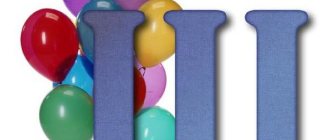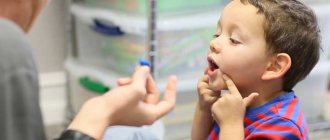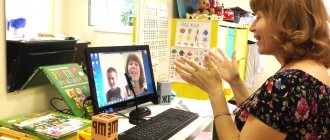The scope of activity of a children's speech therapist is the identification, elimination and prevention of speech disorders.
It is generally accepted that a speech therapist teacher deals only with sound pronunciation correction, but this is far from the case. A speech therapist has a wide range of techniques that allow:
- develop sound analysis skills;
- expand and enrich children's vocabulary;
- develop coherent speech;
- improve the grammatical structure of speech;
- work on the prevention and correction of reading and writing disorders.
The activities of a speech therapist are directly related to the development of various mental processes in a child, such as visual and auditory perception, thinking, memory, attention, development of fine motor skills, and speech.
The tasks of a speech therapist
The main goal of a speech therapist is to promptly prevent and eliminate the adverse consequences of incorrect speech in children. These complications may include the following:
- delayed mental development, since speech not only enriches the child’s thinking with content, but also shapes it;
- mental experiences in a child due to deficiencies in speech function that arise by the age of 5;
- difficulties in school learning - development of secondary speech disorders (dysgraphia, dyssexia);
- in the presence of poorly speaking children in the class, the flow of classes is disrupted, caused by the laughter of classmates, tears and refusal to answer the teacher’s questions;
- in the future, incorrect speech can lead to personal problems and restrictions in choosing a field of professional activity.
Thanks to a consultation with a pediatric speech therapist, it is possible to identify speech pathologies in the early stages and carry out timely correction and prevention of speech disorders.
Speech therapists
Who is a speech therapist?
Speech Therapy Center and its specialists
Diagnosis and treatment by a speech therapist
I'm looking for a speech therapist. Where to begin?
Cost of seeing a speech therapist
Book an appointment with a speech therapist
Who is a speech therapist?
A speech therapist is a specialist who specializes in identifying speech disorders, determining the mechanism of their occurrence and ways of recovery. Despite the fact that each person has individual characteristics of the development of cognitive functions, it is worth contacting a speech therapist both in case of pronounced changes and for diagnostic purposes.
There are a number of speech disorders that a speech pathologist and speech therapist works with:
- Difficulty pronouncing sounds (alalia, dyslalia, rhinolalia, dysphonia, aphonia);
- Violations of timbre, speed of speech (bradylalia, tachylalia);
- Psychoneurological disorders (stuttering);
- Speech disorders associated with other pathologies (deafness, cerebral palsy, injuries of the larynx, speech apparatus, changes in bite, aphasia resulting from previous diseases);
- Impaired text perception when reading and writing (dyslexia, dysgraphia, dysarthria).
A consultation with a speech therapist will help identify not only the consequences, but also the causes of violations, because nasality, lisp, and unclear pronunciation of sounds can have a different nature.
Speech Therapy Center and its specialists
Young patients and their parents are invited to consult with a speech therapist every year, before kindergarten (at 3-4 years old) and before entering school (at 6-7 years old). These are the periods when a specialist speech therapist can give recommendations for speech correction, identify appropriate normative speech skills, and identify areas that require attention. The general psychological development of the child is also of great importance for speech, so the speech pathologist also evaluates this parameter.
A consultation with a speech pathologist and speech therapist will be useful for primary schoolchildren in cases of suspected speech hearing impairment, pronunciation defects, and for the correct formation and development of word formation.
The request “advise a speech therapist” is relevant not only for children, but also for adults, since with age, speech disorders can be aggravated by psychological trauma and complexes. The services of a speech therapist may be needed for patients undergoing rehabilitation after paralysis, stroke, or surgery on the organs of the speech apparatus.
Diagnosis and treatment by a speech therapist
There are generally accepted norms for the timing of speech development, violation of which indicates that the help of a speech therapist is needed.
| Age | Speech skills |
| 4-6 months | Humming, cooing, babbling |
| 1 year | Basic one- and two-syllable words, understanding of spoken speech, onomatopoeia |
| 1.5 years | Definition of relatives (“mom”, “dad”), simple sentences |
| 2 years | Knowledge of body parts, voicing animals |
| 2.5 years | Comparative adjectives, antonyms |
| 3 years | Information about yourself (first name, last name, patronymic, age, address), counting to 10, identifying primary colors, short poems |
| 4 years | Ability to concentrate, listen and retell stories, fairy tales |
An examination by a speech therapist begins with an analysis of the child’s speech in accordance with certain speech therapy cards and diagrams. If there is a suspicion that a speech disorder is associated with a functional pathology, additional diagnostics or research may be necessary, on the basis of which the speech therapist will decide on further correction.
It should be borne in mind that treatment takes place not only in the speech therapist’s office - the key to successful speech restoration is regular home exercises and training.
I'm looking for a speech therapist. Where to begin?
It makes sense to analyze reviews of the effectiveness of speech therapists, and it is better if this is verified and objective information. It’s easier to look for a speech therapist in specialized clinics, preschool institutions with a speech therapy focus - such specialists have a lot of practice and you can get acquainted with the successes of their patients. You can also find a speech therapist on the recommendation of a speech pathologist, otolaryngologist, therapist, pediatrician, child neurologist, or psychologist.
Please also pay attention to the approach to treatment: a highly qualified speech therapist can use several techniques in combination: physiotherapeutic, correctional, and medication.
The correct choice of speech therapist will most likely guarantee effective correction of speech disorders in patients of any age.
Cost of seeing a speech therapist
Since September 2021, speech therapy services are not provided as part of the compulsory medical insurance policy, so by definition, seeing a speech therapist cannot be cheap. An alternative option is to work inexpensively with a speech therapist via Skype, but this is not suitable for everyone. Mostly, patients try to get a paid consultation with a speech therapist, which guarantees an attentive approach and regulated time for classes. Prices for speech therapists vary widely, which is determined by the qualifications of the doctor, the techniques used, and the location of the clinic. The best speech therapists constantly improve their level of education, develop proprietary methods, and follow scientific and medical trends.
Book an appointment with a speech therapist
You can make an appointment with a speech therapist at the clinic reception or in person with the doctor. At the same time, it is much more convenient to make an appointment with a speech therapist via the Internet, since this can be done at any time. Moreover, with such an appointment, there are various options for choosing a doctor: on the AllDoctors website, information about the best speech therapists is collected here. In addition, patients are advised to familiarize themselves with the following information:
Reviews of the work of speech therapists;
Rating of speech therapists indicating the education and qualifications of the doctor;
Addresses of speech therapists and specialized clinics;
Price for a speech therapist's appointment (initial and repeated).
In accordance with your wishes, the list of speech therapists can be sorted by one or another criterion.
When to contact a speech therapist
The following situations may be a reason to visit and consult a speech therapist:
- a child of 2-3 years old does not pronounce individual words, does not strive to communicate with others, is not able to construct a simple phrase;
- a 3-year-old child does not pronounce words completely, speaks incoherently, changes syllables and letters;
- when speaking, there is stuttering, obsessive blinking, involuntary gestures;
- difficulty pronouncing whistling sounds;
- a 5-year-old child has a poor vocabulary, pronounces words without final or initial letters, hissing and whistling sounds are difficult;
- speech is accelerated or slowed down;
- the child is withdrawn, avoids communication with other children;
- a 7-year-old child has difficulty in the descriptive process, making statements, and incorrect combinations of words (agrammatisms);
- The child has difficulty writing and reading, he withdraws into himself, stutters when speaking, and is constantly silent.
Types of activities for speech development
Articulation gymnastics
This is a set of exercises that develop the speech apparatus and promote the production of sounds. Articulation gymnastics helps to pronounce words clearly and clearly even without the help of a speech therapist. Suitable for overcoming any speech defects.
You need to exercise twice a day every day. Each lesson is 3-5 minutes, each exercise is five times. You can add no more than one new exercise per day. All classes must be conducted sitting in front of a table mirror. It’s good if the mother or father does them together with the child.
Examples:
1. “Tube”: the lips are pulled forward, the teeth are closed.
2. “Barrier”: the tongue rises behind the upper teeth, the mouth is slightly open.
3. “Swing”: the tongue moves down and up alternately, in each position for several seconds.
4. “Fence”: the lips are held in a smile, the upper and lower front teeth are exposed. 5. “Pancake”: a relaxed tongue is held behind the lower teeth.
6. “Stretch”: the tongue sticks out and reaches for the nose, chin, and corners of the mouth in turn. 7. “Mushroom”: the child should smile, open his mouth wide and suck his wide tongue to the roof of his mouth.
8. “Horse”: the mouth is open, the lips are held in a smile. You need to suck the tip of your tongue to the roof of your mouth and start flicking your tongue. Performed 5-6 times.
9. “Cup”: smile, open your mouth and bend the edges of your tongue in the shape of a cup.
It is important to learn how to hold the chosen pose for the required time - for example, counting from 1 to 5 or 10.
Development of fine motor skills
The speech center of the brain is located close to the motor center. Scientists have proven that if you develop the fine motor skills of a child’s hands, that is, teach him to perform small, precise movements with his hands and fingers, the speech center will also become active. Such exercises are useful for any speech disorders.
Exercises:
- Games with plasticine. For younger children, it is enough to knead it and sculpt figures of one color; for older children, assign multi-colored figures that are more complex.
- Sorting small items (especially important in the third year of life). Mix two types of beads or buttons, peas and beans, shells and pebbles in one container and ask your child to separate one from the other. You can “tailor” some story to this - for example, one doll likes peas for dinner, and the other likes beans. Gradually complicate the task - let there be objects of three, four or more types in one container. The baby should perform the exercise with two or three fingers and bend the rest.
- Exercise with bulk substances. Teach your child to pour cereals, peas, and lentils from one dish to another (glass, bottle) using a spoon or funnel. Dip small toys and beads into the sand and ask your baby to find them and pull them out with his fingers.
- Rolling balls. The child rolls small balls on a flat surface with his palm or finger and does not allow them to slip out.
- Playing with paper. The child crumples, tears and kneads a piece of paper, learning to put it in the trash can.
- Exercise with raisins. Roll out the dough and invite your child to decorate it with raisins. Let him take each one with two fingers and place it at a distance from each other.
Finger games
One of the types of exercises is “finger games”. This is a short dramatization (often rhythmic, poetic) of stories, fairy tales using fingers. The child repeats the movements of adults.
Examples:
- I knock with a hammer (my fists knock against each other), I want to build a house (the fingertips of both hands are connected, depicting the roof of the house). I am building a tall house (palms, touching each other, rise up), I will live in that house (clap our hands).
- We wrote, we wrote (we depict the process of writing), our fingers were tired. Let's shake our fingers (shaking the hands) and start writing again (a movement similar to that at the beginning of the exercise).
- Four brothers walk towards the eldest (we connect our fingers one by one to make a pinch). Hello big! Hello, Vaska-pointer! (connect the thumb with the index finger). Hello, Little Bear! (large - with medium). Hello, Grishka the orphan! (large - with nameless). Hello, little Timoshka! (big - with little finger).
- The fingers played hide and seek and the heads were removed. Like this, like this, and the heads were removed. (All ten fingers rhythmically bend and straighten at the same time.)
- Our fingers woke up, stretched, stretched and shook. They ran, ran, ran, ran, galloped, galloped - and got tired. (We depict all the movements one by one, then shake our fingers and put our hands on our knees.)
- This finger is grandpa, this finger is grandma, this finger is daddy, this one is mommy, this one is me, this is my family! (At first, the hand is clenched into a fist, then we extend it one finger at a time, and at the end there is an open palm.)
It is advisable to perform the exercises slowly, 3 to 5 times: with one hand, then with the other hand, then with both. After each “session,” relax your fingers and hands by shaking them.
There are no strict rules on the frequency of exercise. The main thing is regularity.
Development of auditory perception, phonemic hearing
Without developed auditory perception, correct oral speech is impossible. Show children pictures of animals and ask them to reproduce the sounds they make. While walking, pay children's attention to the sounds of the street and their differences. Play audio recordings with nature sounds and ask your child what sounds and where. Introduce him to audio fairy tales.
Keep jars of pebbles, cones, vessels with water, pipes and whistles at home. Let the child make the sound from them himself.
Speech therapist Moscow: consultation procedure
Consultation with a specialist does not require any special preliminary preparation. The only thing that is required from parents is to prepare the child for a future conversation, explain the need for it and set up a positive perception of the speech therapist.
Initially, a speech therapist (Moscow) will talk with the child’s guardians or parents and find out the nature of the disorders, their hereditary predisposition, and possible causes of development. During the conversation, the specialist will try to gain the child’s trust by establishing correct contact with him. Further consultation will take place exclusively with the patient himself, during which the speech therapist will establish a violation of speech functions and develop a preliminary plan for subsequent correction.
The speech therapist will provide parents with homework, detailed recommendations, and also plan the first lesson and explain the feasibility of its implementation. The doctor will also demonstrate what techniques can be used to correct the child’s articulation. If necessary, he will show a video or let you listen to audio recordings of past work.
Doctors of other specialties may be present at the consultation with a speech therapist. They will gradually enter into the conversation process so as not to disturb the child. Among specialized specialists, you may need the help of an orthodontist, psychologist, neurologist and other doctors.
During the consultation process with a speech therapist, the specialist practices an exclusively individual approach to the patient, developing his own treatment programs, thanks to which any speech abnormalities can be brought back to normal in a short time.
What happens in our classes:
At the first lesson, the speech therapist diagnoses the current level of speech development of the child, the correspondence of speech status to the child’s age, and determines the nature of speech disorders. Based on the results of the initial examination, an individual plan for correctional work is drawn up, and the need for consultations with specialists in related specialties (psychologist, psychiatrist, neurologist, defectologist, neuropsychologist) is determined.
The speech therapy program, if indicated, includes regular play-based speech therapy sessions, logorhythmics, play and sand therapy as sensory, kinesthetic and speech stimulation.
The specialist will also determine the need for family-parent consultations, help analyze family relationships and see something very important, something that cannot be seen while inside the family system.
The active participation of parents in the implementation of the correctional work plan at home is undoubtedly the key to success!
Pronunciation of complex sounds
Articulation develops gradually; children usually master the pronunciation of complex sounds last. Often in speech the child replaces them with simpler ones or does not pronounce them at all.
Sound "R"
Experts advise studying this difficult sound in a child at the age of 5. If the baby pronounces “r”, but incorrectly, then even earlier - then it’s more difficult to relearn.
To help:
- Tongue twisters with “r” (“Karl stole corals from Clara, and Clara stole Karl’s clarinet.”
- Imitation (just say “r” in your speech in front of the child as clearly and cleanly as possible).
- Production from other sounds that the child pronounces correctly. For example, when a child pronounces “zh”, carefully move the tongue deeper into the mouth with a stick - a “r” is formed. Strengthen the sound by repeating the exercise several times. Or the baby says “z”, lightly touching the alveoli with his tongue, and blows heavily on the tongue. The sound "r" is heard.
- Three-stage exercise: the tongue is “sucked” to the hard palate, the child takes a deep breath through the nose and a short exhale through the mouth, connecting the voice.
- Setting up mechanically (carried out only by a speech therapist - with a hammer, spatula).
Sound "Sh"
The production of this sound occurs at 3–5 years of age.
The most commonly used way is through “s”. The child raises his tongue to the sky, pronounces “s” and smoothly exhales air to make “sh”. Before directly placing the “w,” experts recommend developing articulation of the lips and tongue with the help of exercises:
- A wide smile, exposing both rows of teeth, for 5-7 seconds.
- Licking lips with a “wide tongue” from top to bottom.
- Curling the wide tip of the tongue towards the nose.
- The child stretches out his lips with a straw and blows on a cotton ball for a long time, pushing it, for example, into the corner of the table.
- The baby blows through his closed lips onto a strip of paper - stronger, weaker, stronger again.








